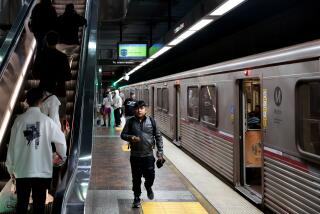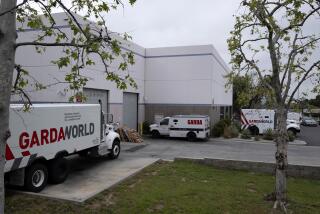Smuggling case shows a security gap at airports
- Share via
FORT LAUDERDALE, FLA. — It took only a few thousand dollars to entice a Comair employee at Orlando International Airport to sneak 14 guns aboard a commercial flight to Puerto Rico last week, authorities say.
But what if the stakes -- and payoff -- were higher?
There’s little doubt that well-financed terrorists could pull off something even more spectacular, said Isaac Yeffet, former security director for El Al Israel Airlines.
“Who can assure me that explosives smuggled on board won’t be next?” Yeffet asked.
Interviews with members of Congress, domestic airport officials and international consultants show major doubt in U.S. aviation’s ability to avoid the threat of an inside job.
In the days after the Sept. 11 attacks, airports across the United States scrambled to intensify screening of passengers and flight crews. Authorities sealed off access to boarding gates and targeted the public.
Less oversight was aimed at the thousands of workers who handle everything from loading baggage to serving hamburgers. It remains a weakness in the system, highlighted by the arrests last week of four people accused of running firearms or drugs through the Orlando airport.
But there are airports in the United States and abroad that are focusing strong security measures on employees as well as passengers.
Miami International Airport is held up as a national model for its 9-year-old program in which every worker is screened.
The screening stations are operated separately from the Transportation Security Administration, the federal agency charged with aviation security, and were set up in 1998 after a drug-smuggling ring was discovered among airport workers.
“Our employee screening is not a reaction to 9/11. Does it add an additional layer of security? You better believe it does,” said Marc Henderson, spokesman for Miami International.
The airport contracts with Miami-based 50 State Security Service Inc. for about $5 million a year to staff walk-through metal detectors and bag-screening machines at entrances to the secure areas of the airport.
A guard who checks ID badges and visually inspects the contents of personal bags also monitors elevators that lead to secure areas, Henderson said.
Recently, Miami International began a test program in which workers send suspicious images of bags on the screening machines to a 24-hour command center in New York staffed by retired New York Police Department bomb technicians.
“If my screeners have a question, they can instantaneously with the click of a mouse request assistance in New York,” said Lauren Stover, director of security for Miami International.
She said the program, which has attracted attention from TSA as well as other airports, has “dramatically curtailed any smuggling activities.”
A TSA official lauded the Miami program but said it may not be necessary for all U.S. airports.
TSA monitors airport employees through background checks at the time they are hired, continuous vetting against the national watch lists of potential terrorism suspects and random spot screenings at airports.
As described by authorities, the alleged Orlando conspiracy was a classic inside job. Investigators say Zabdiel Santiago-Balaguer paid fellow Comair customer-service employee Thomas Anthony Munoz $4,000 to $5,000 to carry a duffel bag of guns and marijuana onto Delta Flight 933 to Puerto Rico.
The men, dressed in their work uniforms, used their identification badges to avoid passenger checkpoints and allow Munoz to board the plane with the weapons Monday morning, authorities said.
Munoz was arrested after the plane landed in San Juan. Santiago-Balaguer and two cousins -- one a former Comair worker -- have since been arrested in a widening investigation into smuggling at the airport.
An Orlando International official said changes were made to certain procedures immediately after Munoz was arrested, and access to certain areas of the airport is now being granted to fewer employees.
But Chris Schmidt, deputy executive director of the airport, said there was no indication Orlando was moving toward an employee-screening system similar to Miami’s.
“I don’t think it’s propitious to compare one airport to another,” he said. “We all have different technology. We all have different issues.”
He stressed that it was Orlando International’s technology that allowed authorities to connect Munoz to Santiago-Balaguer, who was pulled off the Monday flight before its departure because of a tip.
But technology is not a panacea, said Philip Baum, managing director of Green Light, a London-based aviation security training and consulting company.
For all the machines at its airports, he said, the U.S. is not well regarded when it comes to aviation security. That’s because Americans tend to rely on “check-box” exercises that don’t emphasize intuition for odd behavior or nervousness.
“You can’t screen everything every day or you’re going to bring airports to a screeching halt,” he said. The most effective method, he said, may be paying workers enough so that dealing in contraband for cash is less appealing.
Finally, he said, employees should be responsible for policing one another.
“Every employee at the airport has the duty to challenge people in the wrong place, and there are certain types of people who will do that,” he said.
Since Munoz’s arrest, lawmakers have called for federal and congressional investigations into weaknesses in airport security among employees.
Rep. Jerry F. Costello, who chairs a House subcommittee on aviation, recognizes that more work needs to be done. “The system is more secure today than it ever was in the past,” the Illinois Democrat said. But employee security is “an issue that we’re going to have to deal with.”
More to Read
Sign up for Essential California
The most important California stories and recommendations in your inbox every morning.
You may occasionally receive promotional content from the Los Angeles Times.













